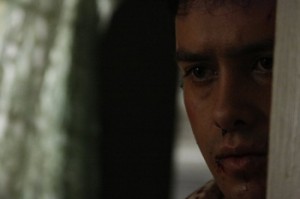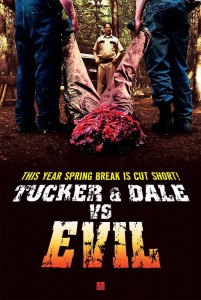#3 -We Are What We Are
Directed by Jorge Michel Grau
The completed version of Jorge Michel Grau’s We Are What We Are had its North American premiere at the Fantasia Film Festival and left audiences very content on their way out. In the same way Let The Right One In reinvented the vampire brand and [Rec] put a clever twist on the epedemic /zombie film, We Are What We Are reinvigorates the cannibal genre with an emotional portrait of a family bound by a terrible secret and driven by monstrous appetites. A middle-aged man dies at the start of the pic, leaving behind his widow and three children alone to support themselves. The devastated family is confronted not only with his loss but with the challenge of finding someone to feed on, for they are cannibals and have always existed on a diet of human flesh consumed in Satanic-like rituals. Now that they must find a way to hunt down their prey, and the eldest son, Alfredo, must gather the courage to accept the challenge before he and his family starve.
Unlike most cannibal films, We Are What We Are eschews the easy options of excessive gore, graphic violence, sex and and cheap laughs to create a deeply moving drama with a spoonful of black comedy and a healthy serving of horror. It’s a slow burning film with an engulfing atmosphere that occasionally leaves you feeling uneasy and other times laughing along. For every moment of bloodshed (of which there is surprisingly little), there are subtleties and surprises that transcend this exhausted genre. Though the violence is nowhere near as brutal as the cannibal movies of the late ’70s or early ’80s, We Are What We Are hasn’t forgotten its roots, administering just enough bloodshed to upset mainstream movie-goers. It also provides us with nice, small moments of color for the characters, short but clever lines of dialogue and plenty of room for development. Director Jorge Michel Grau (who also wrote the script) conjures up one of the best, most imaginative and resonant family-themed horror stories to date. The picture’s leading attribute is Santiago Sanchez’s dazzling photography, a dark and dirty pallette which beautifully highlights the sleazier neighborhoods of Mexico City. Grau balances beautiful, long, static shots while at times having the camera move kinetically, juxtaposed with a remarkably eerie and complex score composed by Enrico Chapel. It is without a doubt one of the most layered, atmospheric, and textured movies of the year. Beautifully crafted and expertly acted, We Are What We Are is a haunting, emotionally involving journey into the macabre.
 It’s not perfect. The setup is far more fun than its pay-off, which unfolds rather too quickly, and the picture falls into the trap of making all the cannibals sad, tragic figures. Without a hero, we are left with little room for suspense and never given any explanation for the bizzare rituals and the need to feed before the clock strikes twelve. Cannibalism is one of mankind’s oldest and deepest taboos. On any level it is never an easy topic, yet the director and absorbing cast manage to effectively mix scares with intelligent storytelling. Despite its minor flaws, We Are What We Are is without question one of the finest genre films of the year and can only become a classic.
It’s not perfect. The setup is far more fun than its pay-off, which unfolds rather too quickly, and the picture falls into the trap of making all the cannibals sad, tragic figures. Without a hero, we are left with little room for suspense and never given any explanation for the bizzare rituals and the need to feed before the clock strikes twelve. Cannibalism is one of mankind’s oldest and deepest taboos. On any level it is never an easy topic, yet the director and absorbing cast manage to effectively mix scares with intelligent storytelling. Despite its minor flaws, We Are What We Are is without question one of the finest genre films of the year and can only become a classic.
– Ricky D
#2 – Tucker & Dale vs Evil
Directed by Eli Craig
Backwoods horror is a sub-genre that can be safely labeled “oversaturated.” The formula should be familiar to even casual horror fans: city slickers traveling through the country roads run head-long into deranged mass murdering, frequently inbred and unhygienic, country folk. Think Texas Chainsaw Massacre, Deliverance or Wrong Turn.
Eli Craig’s twisted throwback to backwoods horror puts everything in reverse. It’s about a case of mistaken intentions to the nth degree. Instead of mass-murdering rednecks, our two unsuspecting hillbillies, Tucker & Dale (Alan Tudyk and Tyler Labine) fall victim to the crazed machinations of a group of rowdy college kids. When Dale shelves his fear of the opposite sex to rescue one of the college co-eds from drowning, her friends mistake him for a backwoods killer. The twist here is that the hillbillies in question are not psychotic, but are actually warmhearted men who fall victim to circumstance.

Director Eli Craig takes a strong command of both the camera and the cast. Twisting genre  conventions, he finds new and innovative ways to kill off the characters. The comedic misunderstandings and misinterpretations that drive the bloodshed continually surprise and delight. While it’s often very funny, it can also be gut-wrenching. Craig adds just the right dose of cinematic references, keeping tongue firmly in the cheek, and the roots of the genre in place. The result is an effective genre mash-up that flips stereotypes on their proverbial ear and a loving homage to all those great fright flicks that peppered the grindhouse inner-city cinemas. Shot with the Red camera in 25 days, cinematographer David Geddes provides a varied visual style that propels the film’s twists and turns while keeping the camera from ever becoming intrusive. The low-budget film is beautifully shot and perfectly paced – at a lean 90-minute running time, the clever premise is played to maximum effect.
conventions, he finds new and innovative ways to kill off the characters. The comedic misunderstandings and misinterpretations that drive the bloodshed continually surprise and delight. While it’s often very funny, it can also be gut-wrenching. Craig adds just the right dose of cinematic references, keeping tongue firmly in the cheek, and the roots of the genre in place. The result is an effective genre mash-up that flips stereotypes on their proverbial ear and a loving homage to all those great fright flicks that peppered the grindhouse inner-city cinemas. Shot with the Red camera in 25 days, cinematographer David Geddes provides a varied visual style that propels the film’s twists and turns while keeping the camera from ever becoming intrusive. The low-budget film is beautifully shot and perfectly paced – at a lean 90-minute running time, the clever premise is played to maximum effect.
With a genre steadfastly refusing to die, we can be grateful for a wonderfully original, fast moving, cheeky and unexpectedly charming ode to friendship and love. This movie is destined for cult greatness, and deservedly so.
– Ricky D


